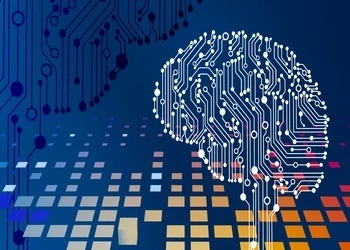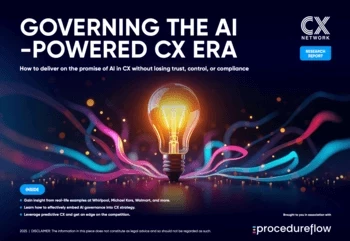The AI evolution: A new architecture for enterprise intelligence
From generative AI to agents and agentic, AI is evolving. Raluca Berchiu explains
Add bookmark
While many organizations are still experimenting with generative AI, drafting reports, analyzing data, or creating content, the next two layers of intelligence, AI agents and agentic AI, are redefining how both enterprises and customer ecosystems function.
Together, these form a progression in enterprise capability: generative AI creates, AI agents apply and agentic AI achieves.
This evolution extends far beyond automation. It introduces a new organizational architecture where intelligence and customer experience (CX) converge, integrating data, decision-making and adaptive execution across every business function.
Forward-looking leaders are already architecting systems that think, decide and execute autonomously, embedding artificial intelligence (AI) into every layer of the customer and operational journey. These organizations are not implementing tools; they are building agentic experience systems that anticipate, personalize and optimize outcomes across industries.

Don't miss any news, updates or insider tips from CX Network by getting them delivered to your inbox. Sign up to our newsletter and join our community of experts.
The three layers of modern AI
1. Generative AI: The creator
generative AI generates new content – text, images and code – from data patterns. It enhances productivity in creative and analytical workflows, accelerating how knowledge is produced and shared.
Applications: content creation, summarization, communication, marketing automation, data synthesis.
2. AI agents: The executors
AI Agents integrate with enterprise platforms, executing tasks and managing workflows. They can read information, respond to clients, update systems and complete processes end-to-end.
Applications: customer service automation, contract review, onboarding, data reconciliation, compliance monitoring.
3. Agentic AI: The operator
Agentic AI goes beyond execution to coordination. It plans actions, prioritizes tasks and adapts to changing conditions using reinforcement learning. These systems autonomously manage multi-step processes, optimize performance and collaborate across business units.
Applications: predictive operations, intelligent decision orchestration, real-time monitoring, supply chain optimization and autonomous compliance management.
Agentic AI marks the point where artificial intelligence evolves into an enterprise nervous system – a connected, adaptive layer that powers decisions, execution and outcomes.
Why this inflection point matters
Operational complexity
Enterprises are now managing interdependent ecosystems: distributed supply chains, evolving regulatory environments and omnichannel service expectations. Static automation cannot handle this complexity. Agentic AI introduces coordination across these moving parts, enabling organizations to make faster and more accurate decisions.
Productivity at scale
AI has become the new driver of performance improvement.
- Salesforce reports AI agents manage nearly half of customer support interactions.
- ServiceNow clients achieve over 50 percent faster case resolution.
- Global research suggests AI could contribute up to US$4.4 trillion annually to global GDP by optimizing workflows and enabling intelligent productivity.
Efficiency is no longer about reducing cost, it is about building adaptive capacity to scale performance.
Acceleration with accountability
The global Agentic AI market is forecasted to surpass $50 billion by 2030. Yet nearly 40 percent of initiatives fail due to lack of readiness, governance and organizational clarity. CXM’s experience shows that success depends on one factor: alignment between technology, leadership and execution.
Early signals across industries
CXM’s work across healthcare, financial services, government and industrial sectors demonstrates how agentic AI is shifting organizations from fragmented automation to fully intelligent operating systems, ecosystems where intelligence, automation and human oversight operate as one.
Healthcare: Building autonomous and connected systems
Healthcare institutions are deploying agentic AI to unify departments that have traditionally operated in silos: clinical, administrative, logistical etc.
- AI-driven Imaging and predictive diagnostics use multimodal intelligence to interpret MRIs, CTs and X-rays within minutes, improving accuracy and detection speed while supporting radiology teams overwhelmed by volume.
- AI-powered documentation and insurance coordination automates clinical notes and claim submissions, accelerating billing cycles and improving patient throughput.
- Ambient scribe AI captures patient encounters, converts speech into structured documentation and ensures EHR completeness with minimal manual input.
- Real-time risk and anomaly detection continuously monitors compliance and operational irregularities, maintaining audit readiness and reducing exposure to penalties.
- AI-enabled supply chain agents manage procurement, inventory and medical device logistics autonomously, forecasting demand, optimizing replenishment and minimizing waste across multiple hospital units.
Hospitals supported by CXM are building these capabilities, transitioning from reactive operations to agentic health systems, organizations that self-coordinate, learn and adapt in real time to improve care quality, operational efficiency and both patient and employee experiences.
By embedding CX principles into the AI architecture, healthcare providers elevate not only performance but also the quality of human experience – enabling clinicians to focus more on care, reducing administrative friction for patients and creating a more compassionate, coordinated journey across the continuum of care.
Financial services: Human understanding at machine speed
Financial institutions are deploying Agentic AI to unify client service, risk management, customer experience and compliance through adaptive, psychology-informed systems.
CXM’s solutions enable contact centers and operations teams to understand customers beyond transactional data. Emotional and behavioral intelligence models analyze tone, stress, empathy and engagement in real time, guiding agents to tailor conversations and decisions.
Key applications include:
- Agentic contact centers that blend emotional analytics, speech recognition and real-time coaching for more effective client resolution.
- Forensics AI that integrates natural language processing and data intelligence for fraud detection and audit automation.
- Intelligent reporting AI that transforms static dashboards into self-updating intelligence layers, continuously interpreting risk, performance and compliance metrics.
These systems do more than automate, they elevate human capability by delivering instant insights and cognitive context, enabling financial leaders to make decisions informed by emotion, data and intent simultaneously.
Government: Institutionalizing intelligence across public systems
Governments are increasingly leveraging Agentic AI to enhance transparency, safety, policy efficiency and real-time decision-making, while transforming the experience of citizens, residents and visitors across ministries and agencies.
CXM partners with public sector institutions to establish AI Centers of Excellence (CoEs) that bring together governance, innovation and execution under a unified framework. These CoEs serve as national intelligence engines aligning data, technology and human capability to deliver measurable societal impact.
They coordinate multiple AI verticals, including:
- Customer and citizen experience AI for adaptive, personalized service delivery that anticipates public needs and responds seamlessly across digital and physical channels.
- Intelligent reporting AI for real-time performance analytics and data-driven policymaking.
- Forensics AI for continuous oversight, risk detection and evidence-based investigations that strengthen institutional integrity.
Through these capabilities, governments are shifting from transactional service provision to agentic governance models, systems that self-learn, self-correct and continuously optimize public value. This evolution enhances efficiency and accountability while redefining how residents, citizens and tourists experience the quality, speed and consistency of government interaction.
The CXM Agentic Readiness Framework™
CXM’s global transformation programs have demonstrated that the ability to scale AI effectively is determined by four interconnected dimensions of organizational readiness. These dimensions ensure that technology deployment translates into measurable, enterprise-wide performance impact.
1. Strategic alignment
Articulate a clear enterprise vision for AI, anchored in growth, resilience and innovation objectives. Alignment between leadership ambition and operational execution defines the foundation for sustainable impact.
2. Workflow redesign
Reimagine and simplify processes before embedding intelligence. Agentic AI amplifies well-designed systems; it cannot correct inefficiency.
3. Governance architecture
Design comprehensive governance frameworks that ensure accountability, data integrity, validation and ethical oversight across every layer of the organization.
4. Human enablement
Equip employees to collaborate confidently with AI, emphasizing judgment, ethical decision-making and adaptive learning. Human-AI synergy becomes a new organizational competency.
The CXM Agentic Readiness Framework™ transforms organizations from AI experimentation to agentic maturity, the ability to continuously sense, decide and act across the enterprise with intelligence, governance and human purpose aligned.
Building enterprise intelligence: AI centers of excellence
CXM enables organizations to institutionalize intelligence through AI CoEs, strategic entities that unify leadership, governance and innovation under a single architecture.
Each CoE functions as the organization’s central intelligence engine, aligning technology investments with strategic priorities and ensuring every AI initiative contributes directly to enterprise value.
CXM-designed CoEs integrate four foundational pillars:
1. Strategic direction: Define the enterprise AI vision, aligning initiatives with measurable outcomes and leadership priorities.
2. Architectural design: Build interoperable data and technology ecosystems that ensure scalability and security.
3. Data integration: Enable seamless information flow across departments, creating a single source of truth for decision-making.
4. Cross-functional talent development: Cultivate multidisciplinary teams that bridge data science, operations, compliance and customer experience.
This structure empowers enterprises to scale AI responsibly, cohesively and at pace, embedding intelligence into everyday workflows while maintaining clarity, transparency and accountability.
Organizations that implement CoEs through CXM move beyond isolated pilots to establish enterprise intelligence as an enduring capability, one that continuously learns, adapts and drives measurable impact across every business unit.
The road ahead: From adoption to orchestration
Generative AI, AI agents and agentic AI are converging into a single, integrated enterprise intelligence stack – an architecture that enables organizations to think, decide and act with precision and purpose.
| Layer | Primary role | Organizational outcome |
| Generative AI | Creates and synthesizes content | Accelerated creativity, insight generation and knowledge flow |
| AI agents | Execute workflows and integrate with systems | Intelligent process execution and cross-functional automation |
| Agentic AI | Plans, adapts and orchestrates operations | Enterprise autonomy, continuous optimization and adaptive performance |
This convergence defines the next generation of transformation – enterprises that operate as intelligent organisms, continuously learning from data, governed by clear principles and empowered by human oversight.
Organizations that master orchestration will not just scale AI, they will scale intelligence itself, embedding adaptability and foresight into every function of the business.
The leadership imperative
Leadership in the agentic AI era is defined by design, not experimentation. The most successful organizations are those that institutionalize intelligence as a core enterprise capability, governed, ethical and human-centric.
Some final thoughts: artificial intelligence is the foundation of the modern enterprise, generative AI revealed what machines can create and AI agents demonstrated how intelligence can be operationalized.
Agentic AI now empowers organizations to achieve outcomes that are autonomous, adaptive and continuously improving.
Therefore, the defining question for leadership has evolved: it is not what AI can do, but how your organization will lead with it.
Quick links
- Closing the transformation gap in healthcare: From strategy to results
- Transforming complexity into growth: Solving what holds your business back
- ChatGPT's "Instant Checkout" lets shoppers buy inside chat
All Access: Future of CX 2025

Join us to hear from industry leaders, innovators, and CX experts as they share insights, strategies, and tools for harnessing customer feedback to drive meaningful change.
Register Now




























